That’s right, kids get arthritis. It is a common misconception that only “old” people are afflicted with arthritis. Nearly 300,000 children in America have been diagnosed with juvenile arthritis.
July is Juvenile Arthritis Awareness Month, a month dedicated to increase awareness over early signs and symptoms of juvenile arthritis and to ease the focus of resources for this battle. The campaign was initiated by the Arthritis Foundation and targets a condition that currently affects 300 000 children nationwide, making it one of the most common childhood diseases in the US.
The word “arthritis” means joint inflammation in Latin, but juvenile arthritis can include eyes, skin and gastrointestinal tract as affected areas. The disorder has a large variety in forms and researchers and doctors alike are working to better understand what the key differences are and how different approaches can help.
A pediatrician may start to determine what’s causing symptoms, but parents may be referred to a rheumatologist (a doctor with specialized training in treating arthritis). Some rheumatologists only treat children, while others only treat adults. Some treat both. The doctor will ask questions about the child’s medical history, when symptoms started, how long they have lasted and about the child’s family history. He or she will also perform a physical exam to look for signs of JA, like limited range of motion, rash, eye symptoms and joint swelling, tenderness and pain. Laboratory tests that look for inflammatory markers and imaging tests (X-rays, CT scans, MRIs) to look for signs of joint damage can also help rule out other causes like trauma or infection.
There is no cure for JA, but with early diagnosis and aggressive treatment, remission (little or no disease activity or symptoms) is possible.
The goals of JA treatment are to:
- Slow down or stop inflammation and prevent disease progression.
- Relieve symptoms, control pain and improve quality of life.
- Prevent or avoid joint and organ damage.
- Preserve joint function and mobility for adulthood.
- Reduce long-term health effects.
Healthy Eating
Eating some foods, like those found in the Mediterranean diet (i.e. fatty fish, fruits, vegetables, whole grains and extra virgin olive oil), and avoiding others (high-fat, sugary and processed foods) may help curb inflammation.
Hot and Cold Treatments
Heat treatments, such as heat pads or warm baths, work best for soothing stiff joints and tired muscles. Cold is best for acute pain. It can numb painful areas and reduce inflammation.
Topical Creams
These creams, gels or stick-on patches can ease the pain in a joint or muscle. Some contain the same medicine that’s in a pill, and others use ingredients that irritate nerves to distract from pain.
Mind-Body Therapies
Meditation, deep breathing, distraction techniques (listening to music or reading) and practicing visualization can help relax and divert attention away from pain, especially during shot time.
Massage and Acupuncture
Massage may help reduce pain and ease stress or anxiety. Acupuncture involves inserting fine needles into the body along special points to relieve pain. If there’s a fear of needles, acupressure, which uses firm pressure, may be used instead.
Supplements
The use of supplements is rarely studied in children, but some supplements that help adults may help children, too. Ask a doctor about which supplements and vitamins may be helpful and which ones may cause side effects and medication interactions.
Stress and Emotions
Kids and teens with chronic diseases are more likely to get depressed. Therapists and psychologists can help kids deal with tough emotions and teach positive coping strategies. A strong support system of friends and family can also provide emotional support during tough times.
Disclaimer: Health experts suggest that you talk to your doctor before you start, change or modify your medications, lifestyle or current treatment regimen.
Reference
http://blog.arthritis.org/news/juvenile-arthritis-awareness-month/
https://www.arthritis.org/diseases/juvenile-arthritis
Picture retrieved from: https://publichealthmaps.org/calendar/2018/7/1/juvenile-arthritis-awareness-month

